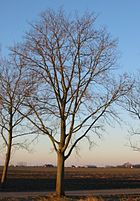- Ulmus 'Commelin'
-
Ulmus hybrid
'Commelin', Netherlands. Photo: Ronnie Nijboer, Bonte Hoek kwekerijen.Details Hybrid parentage Ulmus × hollandica 'Vegeta' × U. minor Cultivar 'Commelin' Origin Baarn, The Netherlands Ulmus 'Commelin' is a Dutch hybrid cultivar released for sale in 1960. The tree was raised at Baarn as clone N274 by the Foundation Willie Commelin Scholten Phytopathological Laboratory [2] in 1940, from a crossing of Ulmus × hollandica 'Vegeta' and a selection of Ulmus minor subsp. minor obtained from the Barbier nursery, Orleans, made in 1929.
Contents
Description
A fast-growing, attractively-shaped tree distinguished by its small pale-green leaves with bright venation. The leaf shape is typically elliptic, with a short acuminate apex. The leaves are sparsely arranged and fall significantly later than those of 'Vegeta'.[1]
Pests and diseases
Resistant to wind and a range of elm ailments, 'Commelin' proved very susceptible to the new, aggressive strain of Dutch elm disease.
Cultivation
'Commelin' initially enjoyed considerable commercial success and over 500,000 had been sold by 1974. However, the tree had only been screened for non-aggressive or semi-aggressive isolates of the causal fungus of Dutch elm disease. When its low resistance to the new strain of the disease became apparent, sales plummeted, and only 500 were sold in 1990.[2][3] Fortunately, neither 'Commelin' nor its equally vulnerable contemporary 'Groeneveld' had sold in great numbers beyond the Netherlands, although it was later used in hybridization experiments in the USA as female parent of several cultivars.
Hybrid cultivars
Etymology
The cultivar is named for Jan Commelin, a Dutch botanist of the 17th century.
Accessions
North America
- Bartlett Tree Experts. No details available
- Holden Arboretum. No details available
- Morton Arboretum. Acc. no. 69-70
Europe
- Brighton & Hove City Council, UK, NCCPG Elm Collection holders. Very large specimen 22m x 72cm in 2005, possible UK champion. Growing on the campus of Brighton University, Falmer. Other trees of size at Elm Drive, Hove (3 trees); St. Ann's Well Gardens, Hove (2 trees); New Church Road, Hove (5 trees); trees with unusual Ulmus glabra graft stocks in Portslade Cemetery (4 trees); The Highway, Moulsecoomb (1 very large tree); Grove Hill Estate (4 trees); University of Sussex (5 trees).
- Grange Farm Arboretum [3], Sutton St. James, Spalding, Lincs., UK. Acc. no. 840.
Nurseries
Europe
- Boomwekerijen 'De Batterijen' [4], Ochten, Netherlands
- Lorenz von Ehren [5], Hamburg, Germany
- PlantenTuin Esveld [6], Boskoop, Netherlands
- Standard Trees [7], Golden Cross, East Sussex, UK
- Westerveld Boomkwekerij B.V.[8], Opheusden, Netherlands (as U. hollandica 'Commelin')
References
- ^ Photograph of 'Commelin' elm. [1]
- ^ Heybroek, H. M. (1993). The Dutch Elm Breeding Program. In Sticklen & Sherald (Eds.)(1993). Dutch Elm Disease Research, Chapter 3. Springer Verlag, New York, USA.
- ^ Burdekin, D. A. & Rushforth, K. D. (Revised by Webber J. F. 1996). Elms resistant to Dutch elm disease. Arboricultural Research Note 2/96. Arboricultural Advisory and Information Service, Alice Holt, Farnham, UK.

This Ulmaceae article is a stub. You can help Wikipedia by expanding it.


